springboot国际化与@valid国际化支持
springboot国际化
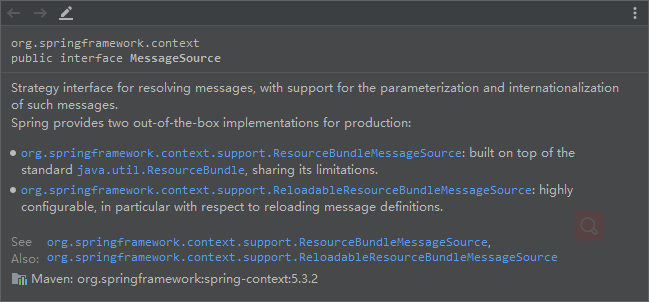
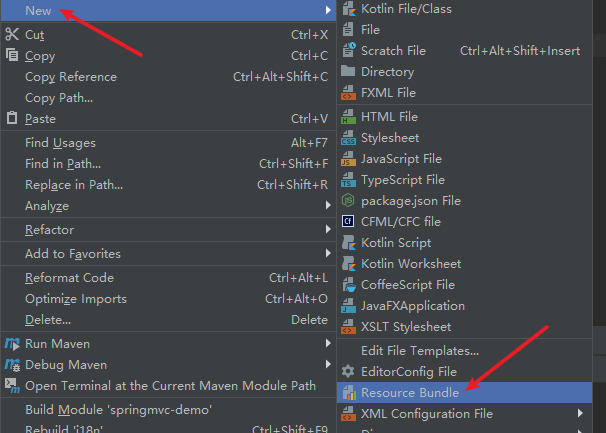
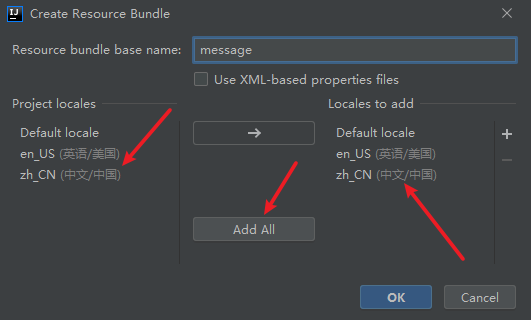

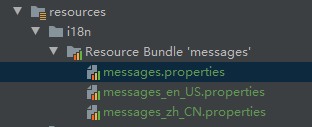
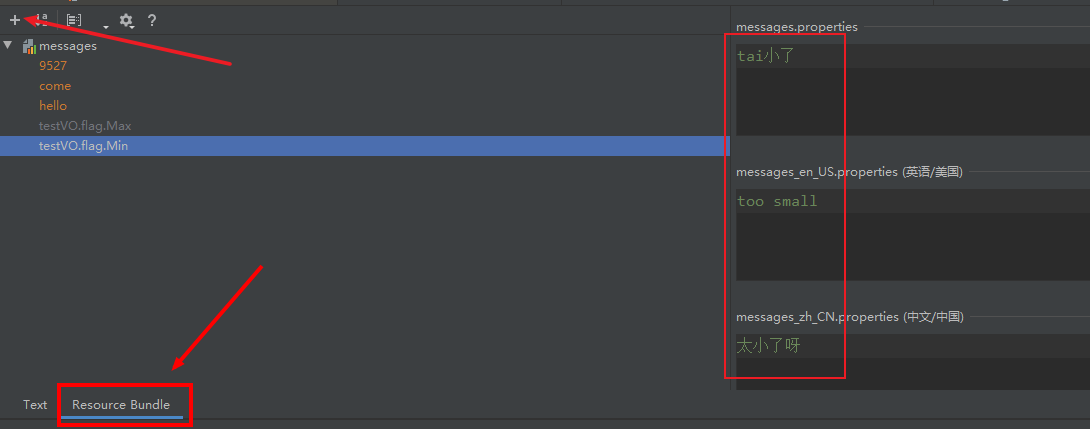
9527=bojack
come=来吧
hello=你好
testVO.flag.Max=tai大了呀
testVO.flag.Min=tai小了9527=jack
come=come
hello=hello
testVO.flag.Max=too big
testVO.flag.Min=too small9527=杰克
come=来吧
hello=你好
testVO.flag.Max=太多了呀
testVO.flag.Min=太小了呀spring:
messages:
basename: i18n/messages # 多个文件用逗号分隔 /**
* 设置默认语言
* @return
*/
@Bean
public LocaleResolver localeResolver() {
AcceptHeaderLocaleResolver acceptHeaderLocaleResolver = new AcceptHeaderLocaleResolver();
acceptHeaderLocaleResolver.setDefaultLocale(Locale.SIMPLIFIED_CHINESE);
return acceptHeaderLocaleResolver;
}### 简体中文
GET localhost:8080/i18n/test
Accept-Language: zh-CN
### 美国英语
GET localhost:8080/i18n/test
Accept-Language: en-USpackage com.springmvc.demo.controller;
import org.springframework.beans.factory.annotation.Autowired;
import org.springframework.context.MessageSource;
import org.springframework.context.i18n.LocaleContextHolder;
import org.springframework.web.bind.annotation.GetMapping;
import org.springframework.web.bind.annotation.RequestMapping;
import org.springframework.web.bind.annotation.RestController;
import java.util.HashMap;
import java.util.Locale;
import java.util.Map;
@RestController
@RequestMapping("i18n")
public class I18nController {
@Autowired
private MessageSource messageSource;
@GetMapping("test")
public Object test() {
Locale locale = LocaleContextHolder.getLocale();
String displayName = locale.getDisplayName();
System.out.println("displayName = " + displayName);
String hello = messageSource.getMessage("hello", null, locale);
System.out.println("hello = " + hello);
Map<String,Object> map = new HashMap<>();
map.put("hello", hello);
map.put("displayName", displayName);
map.put("locale", locale);
String come= messageSource.getMessage("come", null, locale);
map.put("come", come);
String c9527= messageSource.getMessage("9527", null, locale);
map.put("9527", c9527);
return map ;
}
}@valid 参数校验与国际化
/**
* The name of the default message bundle.
*/
public static final String DEFAULT_VALIDATION_MESSAGES = "org.hibernate.validator.ValidationMessages";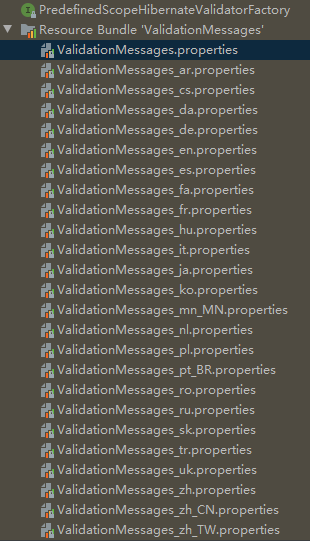
package com.springmvc.demo.vo;
import lombok.Data;
import javax.validation.constraints.Max;//MethodArgumentNotValidException
import javax.validation.constraints.Min;
import javax.validation.constraints.NotNull;
@Data
public class TestVO {
@Min(value = 3)//这里不用写messages了,因为要支持国际化
@Max(value = 10)
private Integer flag;
@NotNull
private Integer age;
}testVO.flag.Max=too big
testVO.flag.Min=too smallspring:
messages:
basename: i18n/messages
mvc:
message-codes-resolver-format: postfix_error_codepackage com.springmvc.demo.controller;
import com.baomidou.mybatisplus.extension.api.R;
import lombok.extern.slf4j.Slf4j;
import org.springframework.beans.factory.annotation.Autowired;
import org.springframework.context.MessageSource;
import org.springframework.context.i18n.LocaleContextHolder;
import org.springframework.core.Ordered;
import org.springframework.core.annotation.Order;
import org.springframework.http.HttpStatus;
import org.springframework.validation.BindException;
import org.springframework.validation.FieldError;
import org.springframework.web.bind.MethodArgumentNotValidException;
import org.springframework.web.bind.annotation.ExceptionHandler;
import org.springframework.web.bind.annotation.ResponseStatus;
import org.springframework.web.bind.annotation.RestControllerAdvice;
import java.util.HashMap;
import java.util.List;
import java.util.Map;
@Slf4j
@RestControllerAdvice
@Order(Ordered.HIGHEST_PRECEDENCE)
public class GlobalExceptionHandlerResolver {
@Autowired
MessageSource messageSource;
@ExceptionHandler({MethodArgumentNotValidException.class, BindException.class})
@ResponseStatus(HttpStatus.BAD_REQUEST)
public R handleBodyValidException(MethodArgumentNotValidException exception) {
Map<String, String> errors = new HashMap<String, String>();
//得到所有的属性错误
List<FieldError> fieldErrors = exception.getBindingResult().getFieldErrors();
//将其组成键值对的形式存入map
for (FieldError fieldError : fieldErrors) {
String[] str= fieldError.getField().split("\\.");
if(str.length>1){
errors.put(str[1], fieldError.getDefaultMessage());
}else {
errors.put(fieldError.getField(), fieldError.getDefaultMessage());
}
String message = messageSource.getMessage(fieldError, LocaleContextHolder.getLocale());
return R.failed(message);
}
log.error("参数绑定异常,ex = {}", errors);
return R.failed("haha");
}
}###
GET localhost:8080/i18n/test
Accept-Language: zh
###
GET localhost:8080/i18n/test
Accept-Language: en-US
###
POST localhost:8080/test
Content-Type: application/json
{
"flag": 2,
"age": 22
}
###
POST localhost:8080/test
Content-Type: application/json
Accept-Language: en-US
{
"flag": 5
} /**
* Parse request locales.
*/
protected void parseLocales() {
localesParsed = true;
// Store the accumulated languages that have been requested in
// a local collection, sorted by the quality value (so we can
// add Locales in descending order). The values will be ArrayLists
// containing the corresponding Locales to be added
TreeMap<Double, ArrayList<Locale>> locales = new TreeMap<>();
Enumeration<String> values = getHeaders("accept-language");
while (values.hasMoreElements()) {
String value = values.nextElement();
parseLocalesHeader(value, locales);
}
// Process the quality values in highest->lowest order (due to
// negating the Double value when creating the key)
for (ArrayList<Locale> list : locales.values()) {
for (Locale locale : list) {
addLocale(locale);
}
}
} @Override
public final String getMessage(MessageSourceResolvable resolvable, Locale locale) throws NoSuchMessageException {
String[] codes = resolvable.getCodes();
if (codes != null) {
for (String code : codes) {
String message = getMessageInternal(code, resolvable.getArguments(), locale);
if (message != null) {
return message;
}
}
}
String defaultMessage = getDefaultMessage(resolvable, locale);
if (defaultMessage != null) {
return defaultMessage;
}
throw new NoSuchMessageException(!ObjectUtils.isEmpty(codes) ? codes[codes.length - 1] : "", locale);
} private String resolveMessage(String message, Locale locale) {
String resolvedMessage = message;
ResourceBundle userResourceBundle = userResourceBundleLocator
.getResourceBundle( locale );
ResourceBundle constraintContributorResourceBundle = contributorResourceBundleLocator
.getResourceBundle( locale );
ResourceBundle defaultResourceBundle = defaultResourceBundleLocator
.getResourceBundle( locale );
String userBundleResolvedMessage;
boolean evaluatedDefaultBundleOnce = false;
do {
// search the user bundle recursive (step 1.1)
userBundleResolvedMessage = interpolateBundleMessage(
resolvedMessage, userResourceBundle, locale, true
);
// search the constraint contributor bundle recursive (only if the user did not define a message)
if ( !hasReplacementTakenPlace( userBundleResolvedMessage, resolvedMessage ) ) {
userBundleResolvedMessage = interpolateBundleMessage(
resolvedMessage, constraintContributorResourceBundle, locale, true
);
}
// exit condition - we have at least tried to validate against the default bundle and there was no
// further replacements
if ( evaluatedDefaultBundleOnce && !hasReplacementTakenPlace( userBundleResolvedMessage, resolvedMessage ) ) {
break;
}
// search the default bundle non recursive (step 1.2)
resolvedMessage = interpolateBundleMessage(
userBundleResolvedMessage,
defaultResourceBundle,
locale,
false
);
evaluatedDefaultBundleOnce = true;
} while ( true );
return resolvedMessage;
}springboot国际化与@valid国际化支持的更多相关文章
- SpringBoot添加对Log4j2的支持
1.在添加对Log4j2的支持前,需要先把SpringBoot默认使用的Logback日志框架排除,修改pom.xml文件: <dependency> <groupId>org ...
- SpringBoot添加对Mybatis的支持
1.修改maven配置文件pom.xml,添加对mybatis的支持: <dependency> <groupId>org.mybatis.spring.boot</gr ...
- 详解SpringBoot 添加对JSP的支持(附常见坑点)
序言: SpringBoot默认不支持JSP,如果想在项目中使用,需要进行相关初始化工作.为了方便大家更好的开发,本案例可直接作为JSP开发的脚手架工程 SpringBoot+War+JSP . 常见 ...
- JavaWeb开发——软件国际化(文本元素国际化)
前几天围绕着JDBC编程进行了系统的学习.现在我们对Java程序数据库操作已经是轻车熟路了.也学会了使用各种框架来帮助我们简化编程. 今天是学习计划的第七天,虽然学习热情没有前几天高涨了.但是,写博客 ...
- springboot 使用i18n进行国际化
1.i18n介绍 i18n(其来源是英文单词 internationalization的首末字符i和n,18为中间的字符数)是“国际化”的简称.在资讯领域,国际化(i18n)指让产品(出版物,软件,硬 ...
- 逐浪web无障碍与国际化以及全民族语言支持白皮书
北京时间2019年5月10日,领先的门户网站与WEB内核服务厂商--上海Zoomla!逐浪CMS团队发布其年度重榜产品:逐浪CMS全民族语言与国际版,体验站点:http://demo2.z01.com ...
- springboot、Thymeleaf、国际化的简单使用
1.项目体系结构 (1)知识体系 springboot:省去了很多繁琐的配置,如:视图解析器.前端控制器等 thymeleaf:获取controller数据逼能够进行展示 集合:用于存储数据,此练习没 ...
- springboot 使用i18n进行国际化乱码解决
方式1.设置国际化的编码和你使用的编译器(IDEA之类)一致,如编译器为UTF-8则在application配置文件中添加 #i18n spring: messages: encoding: UTF- ...
- 国际化之Android设备支持的语种
昨天发了关于iOS支持的语种,文章最后也补了安卓支持语种列表.但最后发现安卓设备支持跟它列的有出入,我重新完全手工整理了一遍. 我将对应的语种在安卓的语言列表里的显示,也全部逐一列出来了,方便大家到时 ...
随机推荐
- PTE 准备之 Personal introduction
Task strategies Be prepared! This is your opportunity to give the admissions officers a first impres ...
- linux 系统用户与用户组管理
关于/etc/passwd和/etc/shadow /etc/passwd 第1个字段为用户名(第一行中的root就是用户名)第2个字段存放的是该账号的口令.第3个字段为一个数字,这个数字代表的用户标 ...
- Min25筛求1-n内的素数和
1 //#include <bits/stdc++.h> 2 #include<cstdio> 3 #include<cstring> 4 #include< ...
- 【Visual Studio调教小记录】C++指针靠前靠后??
本文地址:https://www.cnblogs.com/oberon-zjt0806/p/14631149.html 甜咸之争 经常写C++的基本上避不开使用指针,而且C++中指针类型的写法大体上有 ...
- 干货!Apache Hudi如何智能处理小文件问题
1. 引入 Apache Hudi是一个流行的开源的数据湖框架,Hudi提供的一个非常重要的特性是自动管理文件大小,而不用用户干预.大量的小文件将会导致很差的查询分析性能,因为查询引擎执行查询时需要进 ...
- JS基础学习第三天
条件分支语句switch语句语法: 1234567891011121314 switch(条件表达式){ case 表达式: 语句... break; case 表达式: 语句... break; c ...
- 【MQ中间件】RabbitMQ -- SpringBoot整合RabbitMQ(3)
1.前言说明 前面一篇博客中提到了使用原生java代码进行测试RabbitMQ实现多种交换机类型的队列场景.但是在项目中我们一般使用SpringBoot项目,而且RabbitMQ天生对于Spring的 ...
- 采用QT技术,开发OFD电子文档阅读器
前言 ofd作为板式文档规范,相当于国产化的pdf.由于pdf标准制定的较早,相关生态也比较完备,市面上的pdf阅读器种类繁多.国内ofd阅读器寥寥无几,作者此前采用wpf开发了一款阅读器,但该阅读器 ...
- 数据库MySQL一
P252 1.MySQL 最为主要使用的数据库 my sequel 不容易查找数据 DB数据库 存储数据的仓库,它保存了一系列有组织的数据 DBMS数据库管理系统,数据库是通过DBMS创建和操作的容器 ...
- 黑马架构师v2.5.1 (codeUtil)使用注意事项
资源 1.资料里的codeutil软件有问题,使用时部分类和接口文件名后有一串日期数字等.码云的没问题 2.生成代码后zookeeper的IP改为本机的
